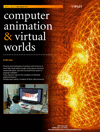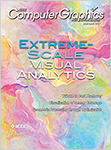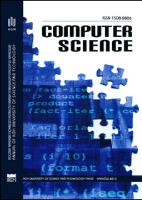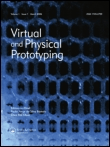
COMPUTER ANIMATION AND VIRTUAL WORLDS
Scope & Guideline
Pioneering Research in Virtual Worlds and Computer Graphics.
Introduction
Aims and Scopes
- Computer Graphics and Visualization:
This area covers the creation and manipulation of visual content using computational techniques, including rendering algorithms, image synthesis, and visualization of complex data. - Virtual and Augmented Reality:
Research in this scope explores immersive environments, user interaction in virtual spaces, and applications of augmented reality technologies across various fields. - Simulation Techniques:
The journal showcases advancements in simulation methodologies, including physics-based simulations, fluid dynamics, crowd behavior modeling, and real-time simulations for diverse applications. - Machine Learning and AI in Animation:
This focus area highlights the integration of machine learning and AI techniques in creating animations, character behavior, and enhancing user interactions in virtual worlds. - Human-Computer Interaction (HCI):
Research on how users interact with virtual systems, including studies on gesture recognition, emotional feedback in virtual environments, and user experience design.
Trending and Emerging
- AI and Machine Learning Applications:
There is a growing trend in applying AI and machine learning techniques for character animation, gesture recognition, and enhancing realism in virtual environments. - Immersive Virtual Reality Experiences:
Research focusing on enhancing user experiences in immersive virtual reality, particularly in applications like therapy, education, and training, has seen a significant increase. - Crowd Simulation and Behavior Modeling:
Studies on crowd dynamics, including evacuation simulations and social interactions, are gaining traction as they address real-world applications in safety and urban planning. - Real-Time Rendering Techniques:
Emerging techniques that improve real-time rendering capabilities and visual quality in interactive applications are increasingly prominent in recent publications. - Emotion Recognition and Affective Computing:
Research on recognizing and simulating human emotions in virtual characters and environments is becoming a vital area, enhancing user engagement and interaction.
Declining or Waning
- Traditional Animation Techniques:
Methods and studies focused on classical animation techniques have seen a decrease, as the field shifts towards more advanced computational and AI-driven methods. - Static Content Generation:
Research related to the generation of static images or non-interactive content is becoming less prominent, with a stronger focus now on interactive and dynamic content. - Low-Complexity Simulations:
There is a noticeable waning interest in low-fidelity simulation models, as advancements in computational power allow for more complex and realistic simulations. - Non-immersive Virtual Environments:
Studies related to non-immersive virtual environments are declining, as the trend moves towards fully immersive experiences in VR and AR. - Basic Computer Graphics Algorithms:
Fundamental algorithms in computer graphics that do not incorporate modern advancements or applications are receiving less attention compared to innovative approaches.
Similar Journals

Journal on Multimodal User Interfaces
Enhancing Interaction: Where Technology Meets UsabilityJournal on Multimodal User Interfaces, published by Springer, serves as a vital platform for scholarly exchange in the rapidly evolving fields of Human-Computer Interaction and Signal Processing. Established in 2008 and continuing through 2024, this journal maintains a high profile in academia, currently ranking in the Q2 category for both fields, indicating its significant contribution to ongoing research and practical applications. With its Scopus rankings placing it at #34 in Signal Processing and #49 in Human-Computer Interaction, it is recognized for publishing high-quality, impactful research. Although it is not an Open Access journal, the Journal on Multimodal User Interfaces remains accessible through institutional subscriptions. Researchers, professionals, and students will find the journal an essential resource for advancing knowledge and fostering collaboration in multimodal interaction technologies, which are crucial for enhancing user experience and developing intelligent systems.

IEEE COMPUTER GRAPHICS AND APPLICATIONS
Advancing the Frontiers of Computer GraphicsIEEE Computer Graphics and Applications is a premier journal published by the IEEE Computer Society, focusing on the rapidly evolving fields of computer graphics and computer-aided design. With an established history since 1981, this journal has become a vital platform for disseminating innovative research and applications that bridge theory and practice. It is indexed in Scopus, holding a respectable rank of #49 in Computer Graphics and Computer-Aided Design and #250 in Software, reflecting its significant contribution to the academic community with a notable 54th and 38th percentile, respectively. While it currently operates without open access options, the journal continues to provide valuable insights that cater to researchers, professionals, and students alike, striving to push the boundaries of technology and creativity. With plans to converge until 2024, IEEE Computer Graphics and Applications remains committed to fostering advancements in the discipline, making it an essential resource for those at the forefront of computer graphics innovation.

Frontiers in Virtual Reality
Innovating the Virtual Landscape of TomorrowFrontiers in Virtual Reality, published by FRONTIERS MEDIA SA, is a leading open-access journal that has been at the forefront of the burgeoning field of virtual reality since its establishment in 2020. Based in Lausanne, Switzerland, this journal provides a vital platform for researchers, professionals, and students eager to explore and disseminate innovative findings related to virtual environments, immersive technologies, and human-computer interaction. With a commendable 2023 ranking placing it in the Q2 quartiles across prestigious categories such as Computer Graphics, Computer-Aided Design, and Human-Computer Interaction, the journal is highly regarded for its rigorous peer-review process and commitment to promoting scholarly communication. Frontiers in Virtual Reality not only advances the understanding of immersive experiences but also encourages interdisciplinary research that bridges the gaps between technology and human interaction. As an essential source of knowledge and a discussion forum for cutting-edge advances, this journal continues to shape the future of virtual reality research with easily accessible content and a responsive editorial approach.

Computer Science-AGH
Exploring Diverse Dimensions of Computer ScienceComputer Science-AGH, published by the AGH University of Science & Technology Press in Poland, is an esteemed open access journal that has been disseminating high-quality research since 2004. With ISSN 1508-2806 and E-ISSN 2300-7036, this journal focuses on a diverse range of areas within the computer science discipline, including but not limited to Artificial Intelligence, Computational Theory, Computer Graphics, and Networks. While it currently holds a Q4 ranking across several categories as of 2023, it actively promotes research that contributes to the academic community's understanding and evolution in the field. The journal's commitment to open access ensures that vital research is accessible to a wider audience, fostering collaboration and innovation. With its comprehensive focus and strategic publication goals, Computer Science-AGH plays a crucial role in advancing the frontiers of computer science research and education, making it an invaluable resource for researchers, professionals, and students alike.

Computer Assisted Surgery
Advancing Surgical Innovation Through TechnologyComputer Assisted Surgery, published by Taylor & Francis Ltd, is an Open Access journal dedicated to advancing the field of surgical innovation through technology and computational methods. Since its inception in 2016, this journal has served as a pivotal platform for researchers and practitioners interested in the convergence of computer science and surgical practices, with a focus on improving patient outcomes and procedural efficiencies. With a notable impact factor reflected in its Q3 category rankings across Computer Science Applications, Family Practice, and Surgery, it stands out for its contributions to the healthcare landscape. The journal is based in the United Kingdom and publishes a range of articles that bridge theoretical research and practical applications, making it an essential resource for students, professionals, and researchers looking to stay at the forefront of surgical technologies. Join a global community dedicated to transformative medical practices in Computer Assisted Surgery.

Proceedings of the ACM on Computer Graphics and Interactive Techniques
Exploring Innovations in Graphics and InteractionProceedings of the ACM on Computer Graphics and Interactive Techniques is a prestigious journal published by the Association for Computing Machinery (ACM), dedicated to advancing the field of computer graphics and interactive techniques. With an impactful presence in both the Q1 quartiles for Computer Graphics and Computer-Aided Design and Computer Science Applications as of 2023, this journal serves as a vital platform for disseminating cutting-edge research, innovative methodologies, and transformative applications. The journal covers a wide array of topics within the realm of computer graphics, fostering a vibrant community of researchers, professionals, and students who are committed to pushing the boundaries of technology. While the journal is not open access, it ensures wide visibility and rigorous peer-reviewed content, making it an essential resource for anyone invested in the dynamic landscape of computer science. Located in New York, USA, the Proceedings of the ACM on Computer Graphics and Interactive Techniques continues to play a crucial role in shaping the future of interactive systems and graphics technology.

Virtual and Physical Prototyping
Bridging Theory and Practice in PrototypingVirtual and Physical Prototyping is a premier scholarly journal published by Taylor & Francis Ltd, which has established itself as a leading platform for innovative research in the fields of Computer Graphics, Computer-Aided Design, Industrial and Manufacturing Engineering, Modeling and Simulation, and Signal Processing. Since its inception in 2006, the journal has gained significant recognition, currently ranked in the Q1 quartile in multiple categories, reflecting its high impact and rigorous standards of scholarship. Now an Open Access journal as of 2023, it provides a unique opportunity for researchers, professionals, and students to share their work widely and engage with a global audience. With its strategic emphasis on the convergence of virtual and physical prototyping technologies, this journal contributes vital knowledge and insights that drive innovation and development in manufacturing processes and design methodologies. Located in the United Kingdom, its comprehensive approach to both theoretical and practical aspects of prototyping ensures that it remains an essential resource for advancing the respective fields it represents.

Multimodal Technologies and Interaction
Connecting Disciplines for Cutting-Edge Interaction.Multimodal Technologies and Interaction, published by MDPI since 2017, is an esteemed open-access journal based in Switzerland, dedicated to the exploration and advancement of innovative multimodal systems that enhance user experience across various digital platforms. With its commitment to disseminating high-quality research in diverse areas such as Computer Networks and Communications, Human-Computer Interaction, and Neuroscience, the journal has rapidly established itself within the academic community, achieving a commendable position in Scopus rankings including Q2 in both Computer Networks and Communications and Computer Science Applications. As an essential resource for researchers, professionals, and students alike, Multimodal Technologies and Interaction fosters interdisciplinary dialogue and supports the development of cutting-edge technologies, ensuring that advancements in multimodal interaction are accessible to a global audience. Scholars can benefit from its Open Access format, allowing unrestricted access to influential studies that shape the future of technology and interaction design.

PRESENCE-Virtual and Augmented Reality
Connecting Disciplines Through Virtual InnovationPRESENCE - Virtual and Augmented Reality is a leading journal published by MIT Press, focusing on the dynamic fields of virtual and augmented reality technologies. With an ISSN of 1054-7460 and E-ISSN 1531-3263, the journal has been a crucial platform for scholarly research since its inception in 1992 and continues to shape the discourse in its field through 2024 and beyond. The journal holds a Q3 category ranking in Computer Vision and Pattern Recognition as well as Control and Systems Engineering, and a Q4 ranking in Human-Computer Interaction and Software, reflecting its diverse impact across multiple disciplines. Although it does not currently offer an open access option, the journal is accessible through institutional subscriptions, providing valuable insights into the latest advancements and practical applications in immersive technologies. By fostering high-quality research and interdisciplinary dialogue, PRESENCE serves as an essential resource for researchers, professionals, and students committed to exploring the transformative potential of virtual and augmented reality in various sectors.

COMPUTER APPLICATIONS IN ENGINEERING EDUCATION
Advancing engineering education through impactful computer applications.COMPUTER APPLICATIONS IN ENGINEERING EDUCATION, published by Wiley, is a leading journal dedicated to the intersection of computer science and engineering education. With its ISSN 1061-3773 and E-ISSN 1099-0542, this journal has become a vital resource since its inception in 1992, providing valuable insights and advancements within its scope. Renowned for its high impact, the journal is categorized in the Q1 in Education and Q1 in Engineering (miscellaneous) quartiles, reflecting its significant contribution to the fields of education and engineering. The journal holds impressive Scopus rankings, including Rank #41 in General Engineering and Rank #38 in General Computer Science, positioning itself within the top echelons of relevant academic disciplines. Although it is not currently an open-access publication, it provides researchers, educators, and students with a platform to explore innovative computer applications in engineering contexts. This journal not only serves as a repository of knowledge but also fosters a community for professionals interested in enhancing educational methodologies through technology.